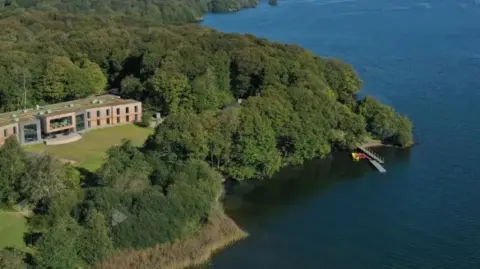Swimmers warned after harmful algae found in lake
 YMCA FYLDE COAST
YMCA FYLDE COASTSwimmers have been told to avoid part of a popular lake after harmful blue-green algae was found in the water.
The blooms, which can make people ill if swallowed, were discovered at the Lakeside YMCA bathing area in Windermere, in the Lake District.
Environmental campaigners said they believed it had been caused by a combination of pollution flowing into the lake and the warmer weather.
The Environment Agency said blue-green algae - which can turn the water green - is "naturally occurring" and can appear across the UK, but advised people to avoid swimming in the affected area.
Blue-green algae is technically not an alga but a collection of microscopic organisms known as cyanobacteria, which is naturally present in lakes and streams.
But when conditions are right it can become abundant and form blooms, which can discolour the water or produce scums on its surface.
These blooms can produce toxins which can cause a rash and make people ill if swallowed. It can also be dangerous to animals, such as dogs.

The founder of Save Windermere, Matt Staniek, said the primary source of nutrients for blue-green algae in the lake came from sewage.
"When you get a combination of sewage flowing into the lake providing the nutrients, which is essentially fertiliser for algae, and nice warm weather like we've got now, that's when we're more inclined to see blue-green algae in the lake," he said.
"This is just going to get worse and worse with climate change."
According to the Environment Agency's bathing water quality map, there are currently three areas in the Lake District swimmers are advised to avoid.
Windermere Lakeside YMCA, Coniston Water Boating Centre and Derwent Water at Crow Park have all been rated poor for water quality.
The Environment Agency confirmed the presence of blue-green algae in the Lakeside YMCA bathing area.
"As a result, the current advice is to avoid swimming in this part of the lake," a spokesperson said.
"Blue-green algae is a naturally occurring environmental phenomenon. It is not unique to Windermere and can appear in many water bodies across the UK, particularly during warm, calm, and dry conditions."
